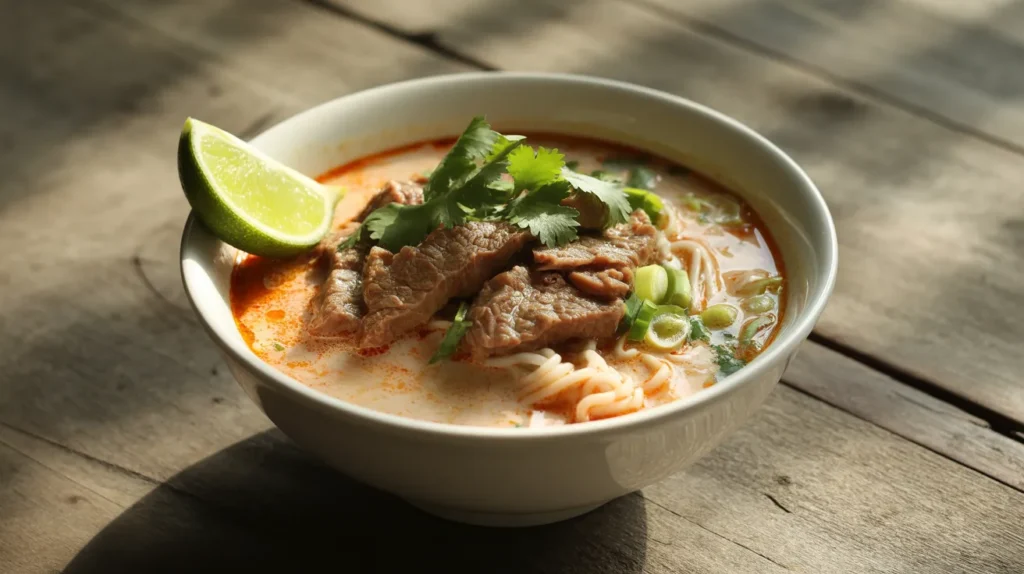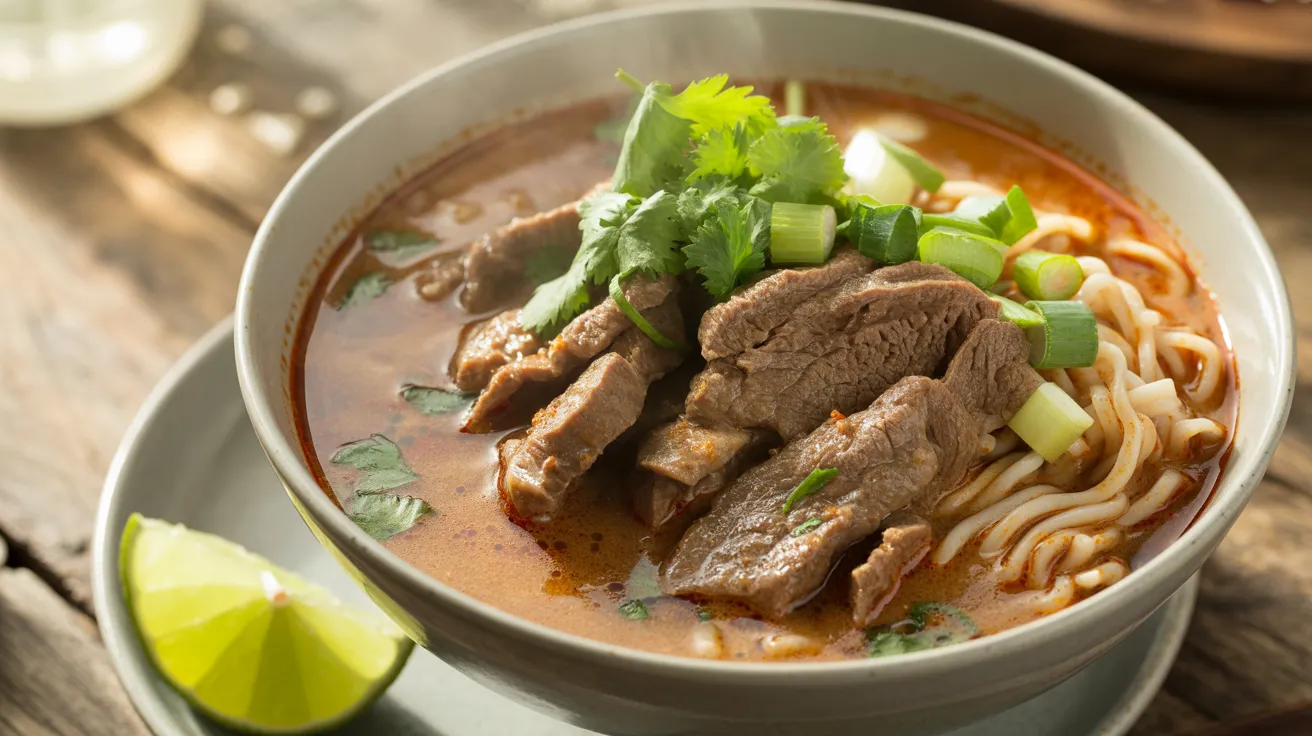This delicious satay beef noodle soup brings together succulent beef strips, creamy peanut-based broth, and tender rice noodles in one comforting bowl. Perfect for beginners, this delicious satay beef noodle soup recipe delivers authentic Asian flavors with simple techniques and pantry-friendly ingredients that create a restaurant-quality meal at home.
SERVES: 4 | PREP: 20 MIN | COOK: 25 MIN | TOTAL: 45 MIN
Ingredients for Delicious Satay Beef Noodle Soup
For the Beef & Marinade:
- 1 lb beef sirloin, sliced thin against the grain
- 2 tbsp soy sauce (low-sodium preferred)
- 1 tbsp cornstarch
- 1 tsp sesame oil
- 1/2 tsp black pepper, freshly ground
For the Satay Sauce Base:
- 1/3 cup natural peanut butter (smooth, no sugar added)
- 3 tbsp coconut milk (full-fat, canned)
- 2 tbsp brown sugar, packed
- 2 tbsp soy sauce
- 1 tbsp rice vinegar
- 2 tsp sriracha sauce (adjust to taste)
- 3 cloves garlic, minced fine
For the Soup:
- 6 cups beef stock (low-sodium, store-bought or homemade)
- 8 oz fresh rice noodles (or 6 oz dried rice noodles)
- 1 medium yellow onion, sliced thin
- 2 tbsp vegetable oil (neutral flavor)
- 1 inch fresh ginger, peeled and grated
- 2 green onions, white and green parts chopped separately
- 1/4 cup fresh cilantro, roughly chopped
- 2 tbsp fresh lime juice
- Salt and white pepper to taste
Detailed Step-by-Step Instructions for Delicious Satay Beef Noodle Soup
Phase 1: Prepare and Marinate the Beef (8 minutes)
Step 1: Prepare Your Workspace Set up a clean cutting board specifically for raw meat. Keep a separate cutting board nearby for vegetables. Have a medium mixing bowl ready for marinating the beef. This organization prevents cross-contamination and makes the process smoother.
Step 2: Slice the Beef Properly Remove the beef from the refrigerator and let it sit for 5 minutes to take the chill off – this makes slicing easier. Using a sharp knife, slice the beef against the grain into strips about 1/4-inch thick and 2-3 inches long. Look for the direction of the muscle fibers and cut perpendicular to them. This technique breaks down tough fibers and ensures tender bites in your delicious satay beef noodle soup.
Step 3: Create the Marinade In your medium bowl, whisk together 2 tablespoons soy sauce, 1 tablespoon cornstarch, 1 teaspoon sesame oil, and 1/2 teaspoon black pepper. Whisk vigorously for 30 seconds until the cornstarch is completely dissolved – you shouldn’t see any white lumps. The cornstarch creates a protective coating that keeps the beef tender during cooking.
Step 4: Marinate the Beef Add the sliced beef to the marinade and use clean hands or tongs to mix thoroughly, ensuring every piece is coated. Set aside for at least 10 minutes while you prepare other ingredients. The acids and enzymes in the marinade begin tenderizing the meat immediately, but don’t marinate longer than 30 minutes or the texture may become mushy.
Phase 2: Prepare the Satay Sauce Base (10 minutes)
Step 5: Gather Satay Ingredients Measure out all your satay sauce ingredients before you start cooking. Have them arranged near your stove in the order you’ll use them. This French cooking technique called “mise en place” prevents mistakes and ensures smooth cooking.
Step 6: Combine Wet Ingredients In a small saucepan, add the peanut butter first, then pour in the coconut milk gradually while whisking. This prevents lumps from forming. The mixture will look separated at first – this is normal.
Step 7: Add Remaining Sauce Ingredients Add brown sugar, soy sauce, rice vinegar, sriracha, and minced garlic to the peanut butter mixture. Whisk everything together until roughly combined. Don’t worry if it looks lumpy at this point.
Step 8: Cook the Satay Sauce Place the saucepan over medium-low heat and whisk continuously for 3-4 minutes. The heat will help emulsify the ingredients. You’ll notice the mixture becoming smoother and more cohesive. The sauce is ready when it coats the back of a wooden spoon and flows smoothly when poured. If it’s too thick, add coconut milk one tablespoon at a time. If too thin, simmer for another minute.
Step 9: Taste and Adjust Remove from heat and taste carefully (it’s hot!). Add more sriracha for heat, brown sugar for sweetness, or soy sauce for saltiness. The sauce should be creamy, slightly sweet, with a gentle heat and rich peanut flavor. Cover and keep warm.
Phase 3: Prepare Aromatics and Vegetables (7 minutes)
Step 10: Slice the Onion Cut the yellow onion in half from top to bottom, then peel off the outer layer. Lay each half flat-side down and slice into thin half-moons, about 1/8-inch thick. Thin slices cook faster and distribute flavor more evenly throughout your delicious satay beef noodle soup.
Step 11: Prepare Fresh Aromatics Peel the ginger using a spoon edge (this removes just the skin without wasting flesh) and grate it using the fine holes of a box grater. Mince the garlic cloves by crushing them with the flat side of your knife first, then chopping finely. Separate the white and green parts of the green onions – whites will cook with the soup, greens are for garnish.
Step 12: Prep Fresh Herbs Wash and dry the cilantro thoroughly. Remove any thick stems but keep the tender ones – they add flavor. Roughly chop the leaves and tender stems. Cut the lime in half and set aside for juicing later.
Phase 4: Build the Soup Base (12 minutes)
Step 13: Heat the Cooking Oil In a large pot or Dutch oven (at least 4-quart capacity), heat 2 tablespoons vegetable oil over medium-high heat. The oil is ready when it shimmers and moves easily when you tilt the pot. A drop of water should sizzle immediately when added.
Step 14: Cook the Onions Add the sliced onions to the hot oil and stir immediately to prevent sticking. Cook for 3-4 minutes, stirring occasionally, until the onions become translucent and slightly golden around the edges. They should smell sweet and have lost their sharp bite. This step builds the flavor foundation for your soup.
Step 15: Add Aromatics Add the minced garlic, grated ginger, and white parts of the green onions to the pot. Stir constantly for 30-45 seconds until very fragrant. Be careful not to let the garlic burn – it will become bitter. You should smell a wonderful aroma filling your kitchen.
Step 16: Add the Stock Pour in the beef stock slowly to prevent splattering. The liquid should come to about 2 inches from the top of your pot. Increase heat to high and bring to a boil, then immediately reduce to maintain a gentle simmer. A rolling boil can make the broth cloudy and tough on the beef.
Step 17: Incorporate the Satay Sauce Using a ladle, add about 1/2 cup of the hot broth to your prepared satay sauce and whisk until smooth. This tempering process prevents the peanut butter from seizing when added to the hot liquid. Pour this mixture back into the pot while whisking the broth continuously.
Step 18: Season the Base Add the remaining satay sauce to the pot and whisk until completely incorporated. The broth should turn a rich, reddish-brown color. Taste and season with salt and white pepper as needed, remembering that the soy sauce already adds saltiness.
Phase 5: Cook the Beef and Noodles (8 minutes)
Step 19: Prepare the Noodles If using dried rice noodles, cook according to package directions in a separate pot of boiling water until just tender. Drain and rinse with cool water to stop cooking. If using fresh noodles, simply rinse with warm water to separate them and remove any starch.
Step 20: Add the Marinated Beef Ensure your soup is at a gentle simmer (not boiling). Add the marinated beef pieces to the soup one at a time to prevent them from clumping together. Stir gently with a wooden spoon to distribute evenly.
Step 21: Cook the Beef Cook the beef for 2-3 minutes, stirring occasionally, until just cooked through. The beef should change color from red to brown but still look tender. Overcooking will make it tough and chewy. The internal temperature should reach 135°F for medium-rare or 145°F for medium.
Step 22: Final Seasoning Check Taste the broth one final time and adjust seasoning. The flavors should be balanced – creamy from the peanut butter, savory from the soy sauce, with a gentle heat from the sriracha. Add more lime juice if you want brightness, or more sriracha for heat.
Phase 6: Assemble and Serve Your Delicious Satay Beef Noodle Soup (5 minutes)
Step 23: Warm the Serving Bowls Place four serving bowls in a warm oven (200°F) for 2-3 minutes, or rinse them with hot water and dry quickly. Warm bowls keep your soup hotter longer and provide a better dining experience.
Step 24: Portion the Noodles Divide the prepared noodles evenly among the four warm bowls. Use tongs or a large fork to create neat portions. The noodles should fill about 1/3 of each bowl, leaving room for the broth and toppings.
Step 25: Add the Soup Using a ladle, carefully pour the hot soup over the noodles in each bowl, making sure each serving gets an equal amount of beef. Fill each bowl about 3/4 full, leaving room for garnishes.
Step 26: Apply Final Garnishes Top each bowl with chopped green onion tops, fresh cilantro, and a squeeze of fresh lime juice. The lime juice adds brightness that cuts through the rich peanut sauce and awakens all the flavors in your delicious satay beef noodle soup.
Step 27: Serve Immediately Present the soup while it’s steaming hot, with lime wedges on the side for additional brightness. Provide spoons for the broth and chopsticks or forks for the noodles and beef.
Chef’s Professional Tips for Perfect Delicious Satay Beef Noodle Soup
• Beef Selection: Choose sirloin, flank steak, or ribeye for the best texture in your delicious satay beef noodle soup. These cuts remain tender when sliced thin and cooked quickly, providing the perfect bite.
• Peanut Butter Quality: Natural peanut butter without added oils or sugars creates the most authentic satay flavor. If your peanut butter is very thick, warm it slightly in the microwave for 15 seconds before mixing.
• Heat Management: Keep temperatures moderate throughout cooking. High heat can cause the peanut sauce to separate or the beef to become tough. Low and slow wins the race for this recipe.
• Make-Ahead Strategy: The satay sauce can be prepared up to 3 days in advance and stored covered in the refrigerator. This actually improves the flavor as the ingredients meld together.
Nutrition Information (Per Serving)
- Calories: 485
- Protein: 28g
- Carbohydrates: 42g
- Fat: 22g
- Fiber: 3g
- Sodium: 890mg
- Sugar: 8g
Creative Variations of Delicious Satay Beef Noodle Soup
Chicken Satay Noodle Soup
Replace beef with 1 lb boneless chicken thighs cut into bite-sized pieces. Chicken thighs stay more tender than breasts and absorb the satay flavors beautifully. Cook until internal temperature reaches 165°F. This variation pairs wonderfully with our hearty vegetable beef soup for a complete meal spread.
Vegetarian Satay Noodle Soup
Substitute extra-firm tofu or tempeh for the beef and use vegetable stock instead of beef stock. Press tofu for 30 minutes to remove excess water, then cube and marinate the same way as beef.
Spicy Indonesian-Style Version
Add 2 tablespoons of sambal oelek (Indonesian chili paste) to the satay sauce and finish with fried shallots and crushed peanuts for authentic Indonesian flavors.
Coconut-Rich Malaysian Style
Double the coconut milk and add a splash of fish sauce for deeper umami flavors. This creates a richer, more indulgent soup similar to our comforting old-fashioned beef stew but with Asian flair.
Storage & Reheating Your Delicious Satay Beef Noodle Soup
Refrigerator Storage: Store leftover soup in the refrigerator for up to 3 days in airtight containers. Store noodles separately if possible to maintain their texture and prevent them from absorbing too much liquid.
Freezer Storage: The soup base (without noodles) freezes well for up to 2 months in freezer-safe containers. Leave 1 inch of headspace for expansion. Thaw overnight in the refrigerator before reheating.
Reheating Instructions: Warm gently over medium-low heat, stirring occasionally to prevent sticking. Add a splash of beef stock or coconut milk if the soup has thickened too much. Never boil when reheating as this can separate the peanut butter and make the beef tough.
Make-Ahead Tips: Prepare all components separately and store in the refrigerator. The marinated beef keeps for up to 24 hours, while the satay sauce improves in flavor over 2-3 days.

Troubleshooting Guide for Delicious Satay Beef Noodle Soup
Problem: Satay sauce is too thick and won’t mix properly
Solution: Thin gradually with warm coconut milk or beef stock, one tablespoon at a time, whisking constantly. If the sauce has seized, remove from heat and whisk in warm liquid until smooth.
Problem: Soup tastes too salty or intense
Solution: Add 1 teaspoon brown sugar and 2 tablespoons fresh lime juice to balance the saltiness. You can also add more coconut milk to mellow the flavors.
Problem: Beef pieces are tough and chewy
Solution: This usually means the beef was overcooked or not sliced against the grain properly. For next time, slice against the grain and cook for no more than 3 minutes. Partially freezing the beef makes slicing easier.
Problem: Peanut butter won’t incorporate and stays lumpy
Solution: Ensure your peanut butter is at room temperature before starting. Warm it slightly in the microwave if needed. Always add liquid ingredients gradually while whisking vigorously.
Problem: Noodles are mushy and falling apart
Solution: Cook noodles separately and add to individual bowls just before serving. If using dried noodles, cook them 1 minute less than package directions as they’ll continue cooking in the hot broth.
Essential Equipment for Making Delicious Satay Beef Noodle Soup
Must-Have Tools:
- Large pot or Dutch oven (at least 4-quart capacity) for cooking the soup
- Medium saucepan for preparing the satay sauce
- Sharp chef’s knife for slicing beef against the grain
- Separate cutting boards for meat and vegetables
- Wire whisk for smooth sauce preparation
- Wooden spoon for stirring without scratching pots
Helpful Additions:
- Fine-mesh strainer for ultra-smooth sauce (optional)
- Ladle for neat serving
- Tongs for handling noodles and beef
- Box grater for fresh ginger
- Garlic press for quick garlic preparation
Organized Shopping List
Meat Counter:
- 1 lb beef sirloin (or flank steak)
Pantry Aisle:
- Natural peanut butter (smooth)
- Rice noodles (fresh or dried)
- Soy sauce (low-sodium)
- Rice vinegar
- Sriracha sauce
- Brown sugar
- Cornstarch
- Sesame oil
- Vegetable oil
Canned Goods:
- Full-fat coconut milk
- Beef stock (low-sodium)
Fresh Produce:
- Fresh ginger root
- Garlic bulb
- Yellow onion
- Green onions (scallions)
- Fresh cilantro
- Lime
Spices & Seasonings:
- Black pepper (preferably whole for grinding)
- White pepper
- Salt
Five Success Secrets for Perfect Results
- Temperature Control is Key: Maintain medium-low heat when making the satay sauce to prevent separation. The peanut butter can seize if heated too quickly, ruining the smooth texture essential for delicious satay beef noodle soup.
- Proper Beef Preparation: Partially freeze the beef for 30 minutes before slicing to achieve paper-thin, even cuts. This technique ensures tender pieces that cook quickly and evenly in the hot broth.
- Sauce Consistency Mastery: The satay sauce should coat the back of a spoon but still pour smoothly. If it’s too thick, it won’t distribute evenly through the soup. If too thin, it won’t provide enough flavor impact.
- Timing is Everything: Add components in the correct order and don’t rush the process. Each step builds flavor layers that create the complex taste profile of authentic delicious satay beef noodle soup.
- Fresh Garnish Impact: Never skip the lime juice and fresh herbs – they provide essential brightness that cuts through the rich peanut sauce and makes each spoonful balanced and craveable.
This comprehensive delicious satay beef noodle soup recipe guides beginners through every detail needed for restaurant-quality results. The combination of tender marinated beef, creamy aromatic broth, and fresh accompaniments creates a satisfying meal that’s perfect for weeknight dinners, weekend cooking projects, or impressing dinner guests with authentic Asian flavors made accessible for home cooks.




